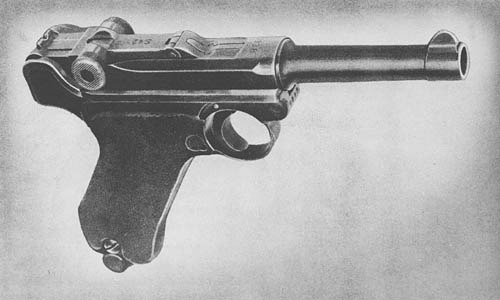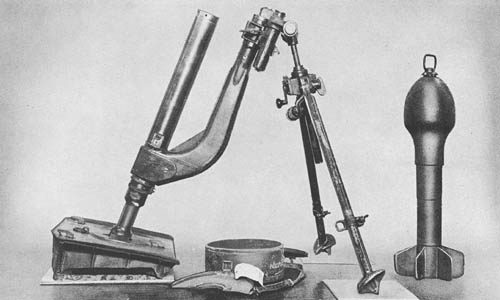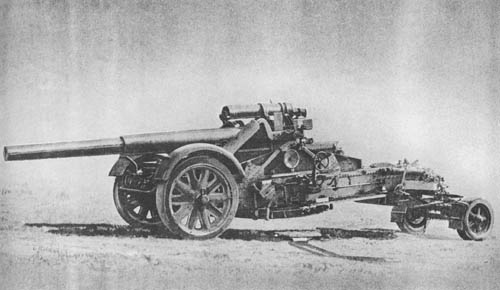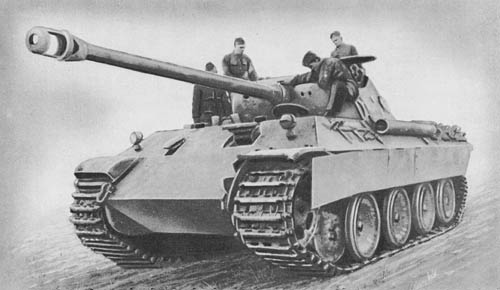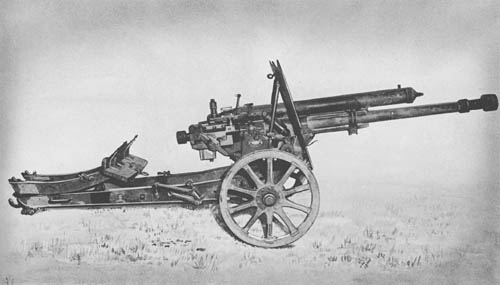
The 4.7 cm Skoda semi-automatic, antitank gun is now apparently obsolescent.
The tube, of monobloc construction, is threaded to take a single baffled muzzle brake and flash hider; the rear is screwed on to the breech ring. The gun recoils on vertical slides riveted to the piece. The breechblock is of the vertical sliding wedge type. The piece is cocked automatically when the breechblock is opened, but provision for cocking by hand is also made.
The recoil mechanism, housed in a cylinder above the piece, consists of a spring recuperator and a buffer cylinder containing water and glycerine.
The top carriage which pivots in traverse on the lower carriage consists of a circular steel base housing machined to hold the trunnion seats for the cradle. The traversing mechanism consists of a handwheel, flexible joint, worm and worm wheel. A grip handle acts as a separate clutch for disengaging the free traverse. The elevating mechanism has a handwheel, beveled gears, flexible joints, shaft, worm and worm wheel.
The carriage has split trails of welded steel construction spread to an angle of about 52° for firing support. In traveling position, they are locked to the axle, and the piece which is rotated through an angle of 180° rests over the trail legs. The wooden-spoked wheels are fitted with steel rims and mechanical brakes which are operated by a hand lever.
The shield is rectangular with a double curve on the top and a cut-away portion for the wheels on either side. It is constructed of a thin 5 mm sheet of armor and has a rectangular sighting aperture on the left-hand side.
SPECIFICATIONS
| Caliber | 47 mm (1.85 ins.) | ||||||||||||||||||||||||||||||||||||
| Weight (complete) | 800 lb. (approx). | ||||||||||||||||||||||||||||||||||||
| Length (overall), (travelling position) | 162 ins. | ||||||||||||||||||||||||||||||||||||
| Length of tube | 6.25 ft. | ||||||||||||||||||||||||||||||||||||
| Breech mechanism | Vertical sliding wedge; semi-auto. | ||||||||||||||||||||||||||||||||||||
| Firing mechanism | Inertia | ||||||||||||||||||||||||||||||||||||
| Recoil mechanism | Hydro-spring | ||||||||||||||||||||||||||||||||||||
| Rifling | 20 lands and grooves; R.H. twist | ||||||||||||||||||||||||||||||||||||
| Muzzle velocity | (A.P.) Wt. 3.6 lb.—2540 f/s | ||||||||||||||||||||||||||||||||||||
| Elevation | 30° | ||||||||||||||||||||||||||||||||||||
| Depression | -4° | ||||||||||||||||||||||||||||||||||||
| Traverse | 45° scaled—360° free | ||||||||||||||||||||||||||||||||||||
| Ammunition | H.E.; A.P. (Uncapped) | ||||||||||||||||||||||||||||||||||||
| Penetration | |||||||||||||||||||||||||||||||||||||
|
|||||||||||||||||||||||||||||||||||||
German: p. 127
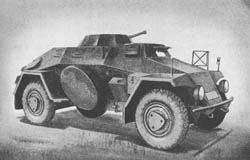
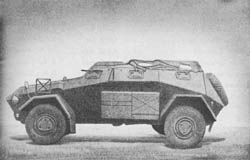 German nomenclature: schwerer geländegängig gepanzerte Personenkraftwagen (Sd. Kfz. 247) mit Einheitsfahrgestell II für schwerer Panzerkraftwagen.
German nomenclature: schwerer geländegängig gepanzerte Personenkraftwagen (Sd. Kfz. 247) mit Einheitsfahrgestell II für schwerer Panzerkraftwagen. 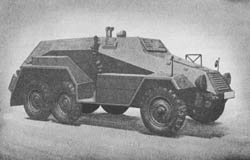 German nomenclature: schwerer geländegängig gepanzerte Personenkraftwagen (Sd. Kfz. 247) mit Fahrgestell des leichter geländegängiger Lastkraftwagen (o).
German nomenclature: schwerer geländegängig gepanzerte Personenkraftwagen (Sd. Kfz. 247) mit Fahrgestell des leichter geländegängiger Lastkraftwagen (o).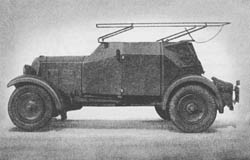 German nomenclature: Funkkraftwagen (Kfz. 14) mit Fahrgestell des mittleren Panzerkraftwagen (o).
German nomenclature: Funkkraftwagen (Kfz. 14) mit Fahrgestell des mittleren Panzerkraftwagen (o).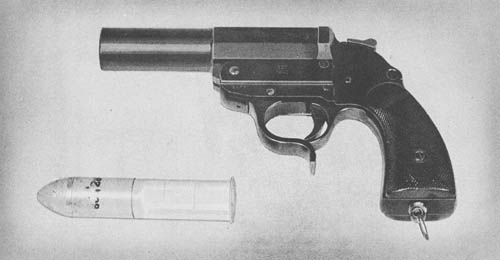
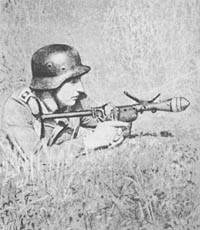 The new Kampfpistole is still a further development. In this weapon, the original model has not been modified by rifling, but a loose steel liner has been fitted. A removable sight is fixed on the barrel, and a folding stock is added. All parts can be readily assembled when in the field. By removal of the liner, any type of ammunition suitable for the original pistol can be fired. However, the H.E. Grenade 361 L.P. cannot be fired from the rifled liner, but use must be made of the smooth-bore liner provided. Furthermore, none of the ammunition designed for the Kampfpistole can be fired in the new Kampfpistole, with or without liner. A new type hollow-charge projectile similar to the hollow charge rifle grenades has been developed for this weapon, but as yet no further information is available.
The new Kampfpistole is still a further development. In this weapon, the original model has not been modified by rifling, but a loose steel liner has been fitted. A removable sight is fixed on the barrel, and a folding stock is added. All parts can be readily assembled when in the field. By removal of the liner, any type of ammunition suitable for the original pistol can be fired. However, the H.E. Grenade 361 L.P. cannot be fired from the rifled liner, but use must be made of the smooth-bore liner provided. Furthermore, none of the ammunition designed for the Kampfpistole can be fired in the new Kampfpistole, with or without liner. A new type hollow-charge projectile similar to the hollow charge rifle grenades has been developed for this weapon, but as yet no further information is available.